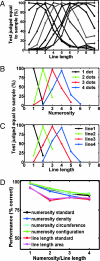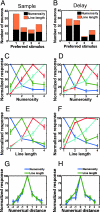Neuronal population coding of continuous and discrete quantity in the primate posterior parietal cortex
- PMID: 17724337
- PMCID: PMC1964866
- DOI: 10.1073/pnas.0705495104
Neuronal population coding of continuous and discrete quantity in the primate posterior parietal cortex
Abstract
Quantitative knowledge guides vital decisions in the life of animals and humans alike. The posterior parietal cortex in primates has been implicated in representing abstract quantity, both continuous (extent) and discrete (number of items), supporting the idea of a putative generalized magnitude system in this brain area. Whether or not single neurons encode different types of quantity, or how quantitative information is represented in the neuronal responses, however, is unknown. We show that length and numerosity are encoded by functionally overlapping groups of parietal neurons. Using a statistical classifier, we found that the activity of populations of quantity-selective neurons contained accurate information about continuous and discrete quantity. Unexpectedly, even neurons that were nonselective according to classical spike-count measures conveyed robust categorical information that predicted the monkeys' quantity judgments. Thus, different information-carrying processes of partly intermingled neuronal networks in the parietal lobe seem to encode various forms of abstract quantity.
Conflict of interest statement
The authors declare no conflict of interest.
Figures






References
-
- Wiese H. Numbers, Language, and the Human Mind. New York: Cambridge Univ Press; 2003.
-
- Woodruff G, Premack D, Kennel K. Science. 1978;202:991–994. - PubMed
-
- VanMarle K, Aw J, McCrink K, Santos LR. J Comp Psychol. 2006;120:416–426. - PubMed
-
- McComb K, Packer C, Pusey A. Anim Behav. 1994;47:379–387.
-
- Wilson ML, Hauser MD, Wrangham RW. Anim Behav. 2001;61:1203–1216.
Publication types
MeSH terms
LinkOut - more resources
Full Text Sources
Molecular Biology Databases

